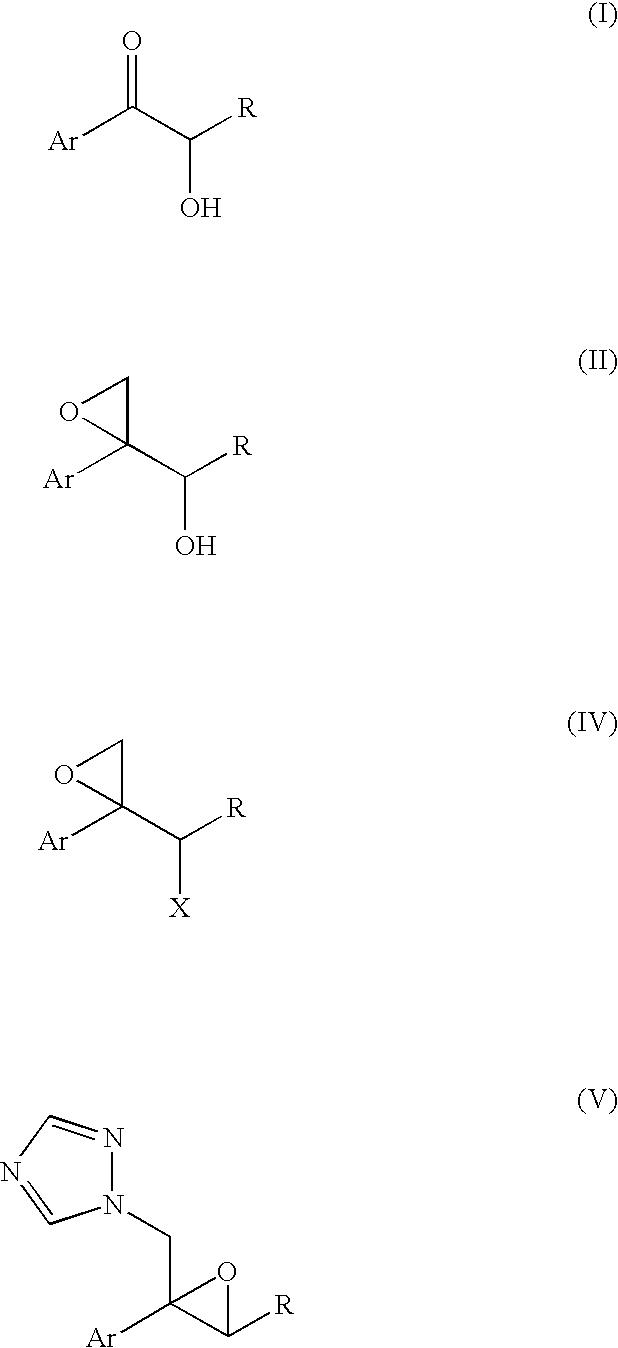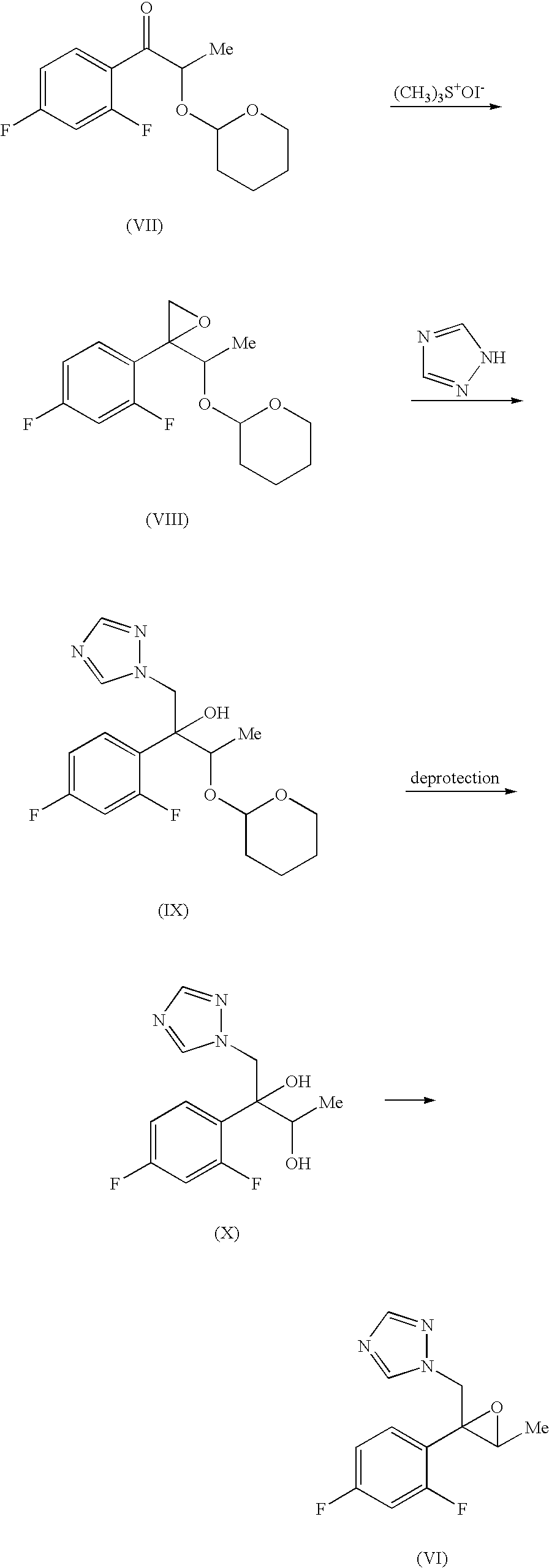Production methods of epoxytriazole derivative and intermediate therefor
a technology of epoxytriazole and production methods, applied in the field of production methods of intermediates, can solve problems such as expected difficulties
- Summary
- Abstract
- Description
- Claims
- Application Information
AI Technical Summary
Benefits of technology
Problems solved by technology
Method used
Image
Examples
reference example 1
(2R)-2′,4′-difluoro-2-hydroxypropiophenone.
[0092]N,N-Dimethylamine (405.7 g, 9.0 mol) was blown in a solution of (D)-methyl lactate (469 g, 4.5 mol) in methanol (234 mL) at 0-15° C. and the solution was stirred in a sealed vessel at 60-65° C. for 24 hr. The reaction mixture was concentrated under reduced pressure to give (D)-N,N-dimethyl lactamide (525 g). To the solution of a part (109 g, 0.93 mol) of the obtained (D)-N,N-dimethyl lactamide in THF (97 mL) were successively added dropwise methanesulfonic acid (0.9 g, 9.4 mmol) and ethyl vinyl ether (74 g, 1.03 mol) at 15-20° C. and the mixture was stirred for 5 hr to give a solution of (2R)-N,N-dimethyl-2-O-(1-ethoxyethyl) lactamide in THF. Subsequently, to this amide solution was dropwise added a solution of 2,4-difluorophenylmagnesium bromide, which had been synthesized from 2,4-difluorobromobenzene (180 g, 0.93 mol) and magnesium (23 g, 0.95 mol) by a conventional method, in THF (485 mL) at room temperature. The mixture was stirr...
reference example 2
(2R)-2′,4′-difluoro-2-hydroxypropiophenone
[0095](2R)-2′,4′-Difluoro-2-(3,4,5,6-tetrahydro-2H-pyran-2-yloxy)propiophenone (9.62 g, 35.6 mmol, synthesized according to the description in Chem. Pharm. Bull., Vol. 41(6), 1035-1042 (1993)) was dissolved in ethanol (99.5%, 50 mL), and pyridinium p-toluenesulfonate (0.89 g, 3.6 mmol) was added. The mixture was stirred at 50-60° C. for 1 hr. After cooling, the reaction mixture was concentrated under reduced pressure to about 10 mL. Water (20 mL) was flown in and the mixture was extracted twice with ethyl acetate (50 mL). The layers extracted with ethyl acetate were mixed, washed with saturated brine (20 mL) and dried over anhydrous magnesium sulfate. After filtration, the filtrate (ethyl acetate solution) was concentrated. The obtained concentrate (about 9.5 g) was subjected to silica gel column chromatography (SiO2, 30 g) and eluted with n-heptane-ethyl acetate (10:1→5:1). The objective fraction was concentrated to give the title compound ...
example 1
(2R,3R)-3-(2′,4′-difluorophenyl)-3,4-epoxy-2-butanol
[0096]Trimethyloxosulfonium bromide (2.66 g, 15.4 mmol) was dissolved in dimethyl sulfoxide (13 mL), and sodium hydride (60% dispersion in oil, 0.27 g, 6.79 mmol) was added by small portions at room temperature. After generation of hydrogen stopped, a solution (5 mL) of (2R)-2′,4′-difluoro-2-hydroxypropiophenone (1.10 g, 5.91 mmol) in dimethyl sulfoxide was slowly added dropwise, and the mixture was stirred for about 30 min. After completion of the reaction, the reaction mixture was added dropwise to water (50 mL) and extracted twice with ethyl acetate (50 mL). The layers extracted with ethyl acetate were mixed, washed twice with water (20 mL) and dried over anhydrous magnesium sulfate. After filtration, the filtrate (ethyl acetate solution) was concentrated. The obtained concentrate was subjected to silica gel column chromatography (SiO2, 10 g) and eluted with n-heptane—ethyl acetate (10:1→2:1). The objective fraction was concentr...
PUM
| Property | Measurement | Unit |
|---|---|---|
| temperature | aaaaa | aaaaa |
| temperature | aaaaa | aaaaa |
| temperature | aaaaa | aaaaa |
Abstract
Description
Claims
Application Information
 Login to View More
Login to View More - R&D
- Intellectual Property
- Life Sciences
- Materials
- Tech Scout
- Unparalleled Data Quality
- Higher Quality Content
- 60% Fewer Hallucinations
Browse by: Latest US Patents, China's latest patents, Technical Efficacy Thesaurus, Application Domain, Technology Topic, Popular Technical Reports.
© 2025 PatSnap. All rights reserved.Legal|Privacy policy|Modern Slavery Act Transparency Statement|Sitemap|About US| Contact US: help@patsnap.com



